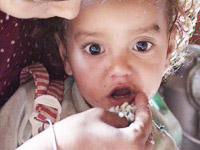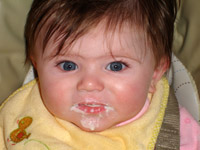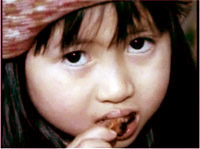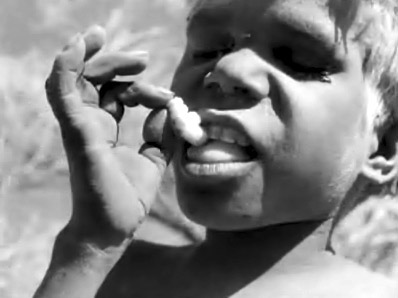|
Anthropology in the News
|
|
|||||||||||||||||||||||||||||||
 "Palermo, Sicily Italy |
 A Fistfull of Rice Nepal |
 Claire Kathleen Roufs U.S.A. |
 "Eating Rat At The New Year" Vietnam National Geographic |
 Desert People Australia |
TimelinesSeveral fine food timelines are available on the web:
Calendar of Nutrition and Health Events search "food history" and "food timeline" and "Neolithic Revolution" on JSTOR |
From The Scout Report, 9 January 2009 (Volume 15, Number 1) The food timeline <http://www.foodtimeline.org/index.html>
|
| Major Events / Items
|
|||
| "The forst microwave ovens were developed, but did not become practical until the late 1960s and early 1970s." -- Popkin, 2010, p. 73. | |||
| First refrigerators for household use were developed by the General Electric Company. "However, without Freon gas, which was developed in the 1930s, the earlier refrigerators (pre-1930) were dangerous." -- Popkin, 2010, p. 73. | |||
| Banana split invented in Wilmington, Ohio (Banana, Koeppel 2008, p. 249) | |||
| Banana split invented in Davanport, Iowa (Banana, Koeppel 2008, p. 249) | |||
| Banana split invented in Columbus, Ohio (Banana, Koeppel 2008, p. 249) | |||
| Banana split invented in Latrobe, Pennsylvania (Banana, Koeppel 2008, p. 249) | |||
| "Agricultural depression" in Europe; U.S.A. begins to become food power -- Jean Louis Flandrin, Massimo Montanari, Albert Sonnenfeld, 1999, p. 489 | |||
| Louis Pasteur and Claude Bernard complete first pasteurization test | |||
| End of the "Prescientific Period" | |||
| The dictionary of the Académie Française recognizes the word restaurant in reference to the establishment of a restauranteur -- Jean Louis Flandrin, Massimo Montanari, Albert Sonnenfeld, 1999, p. 475 | |||
Jean-Anthelme Brillat-Savarin publishes Physiologie du goût
|
|||
| Nicolas Appert, publishes L'Art de conserver les substances animales et végétales (or The Art of Preserving Animal and Vegetable Substancess), the first cookbook of its kind on modern food preservation methods | |||
(1802?) |
Nicolas Appert, the "father of canning," begins industrial scale food production, setting up a food-preserving factor at Massy, Essone, France -- Jean Louis Flandrin, Massimo Montanari, Albert Sonnenfeld, 1999, p. 486 | ||
| ". . . Cooking was removed from the 'medicine' category [in Perrot's catalog], separated from books on 'hygiene' and 'dietetics' and from treatises on wine, tea, coffee, and chocolate, and lumped together with such other aristocratic arts as horsemanship, fencing, dance, and hunting," -- Jean Louis Flandrin, Massimo Montanari, Albert Sonnenfeld, 1999, p. 431 | |||
| Cooking first classified as an art, in Traité des livres rares -- Jean Louis Flandrin, Massimo Montanari, Albert Sonnenfeld, 1999, p. 431 | |||
| Menon introduced the expression nouvelle cuisine in Vol. 3 of Nouveau Traité de cuisine -- Jean Louis Flandrin, Massimo Montanari, Albert Sonnenfeld, 1999, p. 398 | |||
| ". . . Neapolitan Francesco Capelli, known as 'Procope,' opened the first cafe in Paris on the rue de Tournon" -- Jean Louis Flandrin, Massimo Montanari, Albert Sonnenfeld, 1999, p. 472 | |||
Catherine de' Medici marries Henry II of France "And Catherine took her cooks to France with her. They were probably the first great chefs de cuisine in that land, and galling though the fact may be to those Frenchmen who mix patriotism with their love of fine food, they were Italians every one.... Their innovations burst like a bomb over all the noble tables of Paris." – MFK Fisher, Serve It Forth (Harper & Brothers, 1937) |
 Catherine de' Medici, attributed to François Clouet, c. 1555 |
||
| Henry VIII of England breaks with Rome End of the Middle Ages in Britain (Black, The Medieval Cookbook, 1992) |
|||
| Juan Sebastián Elcano becomes the first person to circumnavitate the globe | |||
| Moctezuma meets Cortés | |||
| 23 April 1516 (1487) |
Reinheitsgebot, "Bavarian Purity Law" originated | ||
| Juan Rodríguez Bermejo aboard the Pinta – looking for a westward (from Europe) alternate route to the Spice Islands – sights Guanahani, later re-named by Christopher Columbus as San Salvador, hence follows the Basques and Vikings and one or more groups of American "Indians" in "discovering" America – "Christopher Clumbus," Wikipedia | |||
| "...The last Muslim leader, Muhammad XII, known as Boabdil to the Spanish, surrendered control of Granada, to Ferdinand and Isabella, Los Reyes Católicos ('The Catholic Monarchs')...." – "Granada," Wikipedia | |||
| Portuguese navigators round The Cape of Good Hope, "a major milestone in the attempts ... to establish direct trade relations with [the Spice Islands] and the Far East" – Wikipedia | |||
| Crusades in the Middle East "The Crusaders who descended on [the Middle East] During the Middle Ages brought some of their own traditions with them, and they stayed in some areas for nearly 200 years. As the crusaders returned to Europe, they brought with them the culinary influences they had experienced during their time in the Middle East. Muslim armies occupied Spain and Sicily for hundreds of years before, throughout, and after the Crusades. Following the expulsion of the Arab armies from Spain, the Spanish exported many culinary techniques and ingredients to the Americas (having been influenced themselves by the Middle Eastern peoples). Throughout these periods, the customs and cuisines of the Middle East spread across much of the world." – Jeremy MacVeigh, International Cuisine (Delmar, Cengage Learning, 2009, p. 6) |
 Siege of Antioch, gravure by Sébastien Mamerot, 1490 |
||
(1077 ?) |
Bayeux "Tapestry" probably completed |  (enlarge) Bayeux Tapestry feast (Black, The Medieval Cookbook, 1992, p. 21) |
|
| Battle of Hastings Saxon lord Harold II of England killed in battle, Duke William II of Normandy assumes English throne "[The Norman nobles] at once began importing spices, foreign herbs and other food plants, and even animals (for instance, rabbits); and they introduced upper-class Saxons to their own food tastes, along with elements of their own language." (Black, The Medieval Cookbook, 1992, p. 20) |
|||
| Moors conquer most of Iberian Peninsula |  View from a room inside the Alhambra palace complex, Granada, Spain |
||
| Romulus Agustus abdicates to officially end Western Roman Empire Beginning of the Middle Ages in Britain (Black, The Medieval Cookbook, 1992) |
|||
| End of Prehistory (writing begins) dates vary regionally |
|||
| 3,300 B.C. "Ötzi" The Iceman | |||
| The "Neolithic Revolution" begins food production in the Middle East (agriculture and village life begin...) dates for the "Neolithic" and for food production in general vary regionally |
|||
| Last glacial period ends | |||
"Homo sapiens neandertalensis |
|||
| c. 300,000 | fire hearths |
||
| c. 400,000 | control of fire | ||
| c. 1 mya... | oldest probable use of fire | ||
| Homo erectus meat eating becomes an important part of the diet |
|||
| Early Homo (Homo habilis...) |
|||
| creation of the universe | |||
|
* c. = circa = about |
|||
|
|
||||||||||||||||||
| Other: check Canvas |
Exams: Midterm |
Project |
Discussions |
|---|
 Page URL: http:// www.d.umn.edu /cla/faculty/troufs/anthfood/aftimes.html Site Information |
||
View Stats |
|